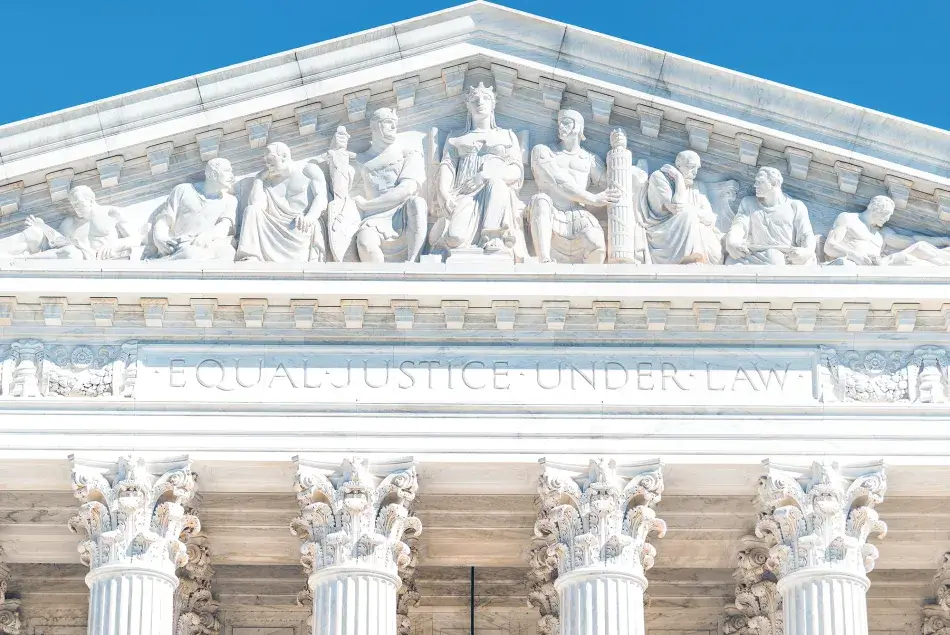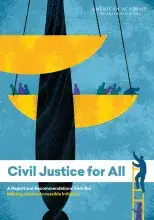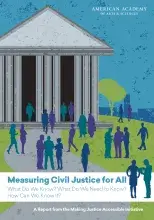
An engraving above the western entrance to the U.S. Supreme Court proclaims a bold ideal for the American judicial system: “equal justice under law.” Unfortunately, the nation has not yet achieved the Court’s aspiration. While many Americans experience legal issues at some point in their lives, not everyone has access to the legal assistance that they need.1
Over the last year, the urgency of the civil justice gap has grown more evident.2 The avalanche of job losses prompted by the COVID-19 pandemic overloaded state unemployment offices and led to long waits for people seeking the insurance benefits to which they were entitled.3 Although there is a current moratorium on evictions, advocates fear a housing catastrophe when that protection expires. Tenants with legal representation fare far better than those without, but a recent study of a New York City housing court found that while only 1 percent of tenants had a lawyer, 90 percent of landlords did.4 Stay-at-home orders and closed schools placed new strains on families and made it more difficult for those experiencing domestic abuse to seek help – creating a “pandemic within a pandemic.”5
The Academy’s Making Justice Accessible project advocates for changes to improve low-income Americans’ access to civil legal help. Its final report, Civil Justice for All, offers seven recommendations and presents several case studies of successful initiatives in family law, health, housing, and veterans’ issues across the United States.
The project’s seven recommendations:
- Dedicate a consequential infusion of financial and human resources to closing the civil justice gap, and seek a significant shift in mindset – extending beyond lawyers the duty and capacity to assist those with legal need – to make genuine strides toward “justice for all”
- Increase the number of legal services lawyers who focus on the needs of low-income Americans
- Increase the number of lawyers providing pro bono and other volunteer assistance, to supplement the corps of legal services lawyers
- Bring many new advocates – service providers who are not lawyers – into the effort to solve civil justice problems
- Foster greater collaboration among legal services providers and other trusted professionals – such as doctors, nurses, and social workers
- Expand efforts to make legal systems easier to understand and use through the simplification of language, forms, and procedures and the wider use of technology
- Create a national team, or even a new national organization, to coordinate the efforts listed above, collect much-needed data on the state of civil justice, and help identify and publicize effective innovations that improve access.6
These recommendations build on the work the legal community is already doing in select states and municipalities to meet the needs of low-income Americans – work that the report uses as a model for future nationwide innovation. For instance, Civil Justice for All draws on successful court navigator and legal technician programs in New York City and Washington State as examples of how to simplify legal processes to allow nonlawyers to provide civil justice help to more people at a lower cost.7 While additional funding for a variety of legal services is an important and necessary step, the report recognizes that funding alone is insufficient. National coordination, collaboration, and action are required to make “equal justice under law” real for all Americans. As the report asserts, “Access to legal services . . . should not be a matter of geography, timing, or luck. Equal justice is a right, not a privilege.”8
The Making Justice Accessible project also calls for raising the visibility of civil justice access outside of the legal community. Many people who experience civil justice problems do not recognize them as such or know how to seek help. Even when help is sought, the vast majority will not receive it: a recent study found that only 14 percent of the low-income Americans who reported a civil legal problem received adequate legal assistance.9 This unmet need diminishes people’s trust in institutions. It results in high public costs as people lose housing or go without preventative healthcare. And it overwhelms the capacity of legal-aid programs meant to provide a safety net. “The civil justice gap . . . exacerbates the inequalities that undermine our society. At-risk populations – by income, race, gender, and education level – cannot receive justice if they cannot access even basic legal advice. The outcomes – evictions, family separations, job loss, and other hardships – are often catastrophic.”10

The release of the Civil Justice for All report in September 2020 was a culmination of conversations that began in November 2015, when the Academy convened a two-day conference on civil justice issues. Judges, lawyers, legal-aid providers, clinicians, legal scholars, government officials, and business leaders gathered at the House of the Academy to discuss the barriers low-income Americans face in seeking legal assistance, as well as what they, as stakeholders, could do to better meet those needs. The Making Justice Accessible project emerged from that meeting. Cochairs Kenneth C. Frazier (Merck & Co.), John G. Levi (Legal Services Corporation; Sidley Austin LLP), and Martha L. Minow (Harvard University) have stewarded the project to understand the civil justice gap, analyze its consequences, and design a better way forward.
Five subcommittees helped to inform the work of the project: family (cochaired by Tonya Brito and Lance Liebman); health (cochaired by John Levi and Allison Rice); housing (cochaired by Colleen Cotter and Diane P. Wood); and veterans (cochaired by Nan Heald and Martha Minow) – plus innovation in each area (cochaired by Elizabeth Chambliss and Andrew Perlman). In addition, legal scholar Lincoln Caplan (Yale Law School) oversaw a pro bono research team from the law firm of WilmerHale that conducted numerous interviews focusing on the priorities identified by these subcommittees.

In addition to the Civil Justice for All report, the project also released an issue of Dædalus in 2019 on “Access to Justice,” guest edited by Lincoln Caplan, Lance Liebman, and Rebecca L. Sandefur, which examines the national crisis in civil legal services facing low-income Americans. And in February 2021, the project published a white paper, Measuring Civil Justice for All: What Do We Know? What Do We Need to Know? How Can We Know It? that includes an overview of existing information deficits in the field and provides a blueprint for gathering the data necessary to fully understand civil justice activity in the United States.
Measuring Civil Justice for All asks two fundamental questions: Is justice open to all? And is the justice system fair to all?11
The white paper outlines what kinds of civil justice data are currently being collected and by whom, as well as what information is nonexistent, not publicly available, or not analyzable in its current form. The paper recommends more systematic data collection by the courts, legal-aid programs, and other service providers to allow for a comprehensive understanding of who is using their services and with what results. It also recommends that questions about civil justice access be added to existing national surveys of Americans and that data be collected from Internet search engines, as many people who face civil justice issues never seek legal help.
More ambitiously, the paper advocates for the creation of a civil justice data commons, which would make it easier to meet the needs of those seeking assistance and to track their outcomes. A data commons would also allow researchers to answer important civil justice questions, such as how often people encounter multiple civil justice issues simultaneously. While it entails upfront costs and presents some regulatory and analytical challenges, a data commons would help public and private legal-aid programs become more effective and efficient.
The Academy is committed to ensuring that the Making Justice Accessible project has a lasting impact. In addition to connecting with thought leaders in the legal and business communities to build consensus around advancing the project’s recommendations, the project team will explore opportunities to collaborate with other institutions committed to closing the civil justice gap. Those efforts might include developing state court pilot programs to digitize and streamline legal processes, building an information hub for sharing best practices around civil justice innovation, and expanding legal services by nonlawyers through targeted outreach to other professions and institutions that serve low-income Americans.
To learn more about the Making Justice Accessible project, visit the Academy website (www.amacad.org/project/making-justice-accessible).